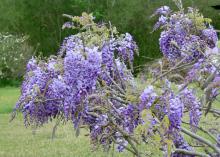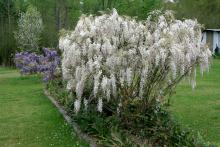Information Possibly Outdated
The information presented on this page was originally released on March 19, 2012. It may not be outdated, but please search our site for more current information. If you plan to quote or reference this information in a publication, please check with the Extension specialist or author before proceeding.
Choose hardy wisterias for colorful hanging flowers
Every spring, I look forward to seeing wisterias bloom. It’s incredible how high these vines can climb into trees. They are a familiar sight along roadsides, and I really enjoy the 55-mile-per-hour flower show I get as I drive along the highways in Mississippi.
In this setting, these vigorous and aggressive vines seem to be out of reach for the ordinary home landscape. But wisteria vines can actually be used in a more confined space, assuming you are committed to keeping the vine in place through training and pruning.
Never allow wisteria vines to grow randomly. Consistent pruning will help control this vine’s vigorous growth and actually promote more flowering each spring.
Wisterias make great landscape plants because they are hardy and can be extremely long-lived.
If you provide a sturdy trellis or pergola, this climbing vine can provide beneficial summer shade. But be careful where you grow it. The plant climbs using twining stems that grab hold of any structure available.
Wisterias can be trained into shrub form using judicious pruning and training of the main stem, much like the training used for growing grape vines. The older wisteria trunks can be extremely twisted and many inches in diameter.
Wisteria’s landscape value is enhanced in the spring by its pendulous flowers. Along the road, we commonly see purple and white colors. For the landscape, the nursery trade has a variety of colorful selections including white, pink and blue. These colors often are grafted plants. Check with your local garden centers for availability.
There are two species commonly found for the landscape. The Japanese wisteria, Wisteria floribunda, is perhaps the most common. Its pendulous flower clusters open along with the emerging foliage.
The other species is Chinese wisteria, or Wisteria sinensis. The flower clusters of the Chinese wisteria are up to 12 inches long or more. The flowers open before the foliage emerges. The timing of flowering is very close to the flowering dogwood, and these would make a fantastic combination planting in the landscape.
Always plant wisterias in full sun to get the most out of their beautiful spring flowers. The soil needs to be consistently moist and fertile. Use quality compost and a controlled-release fertilizer after flowering.
Sometimes home gardeners can be frustrated by a lack of flowering. If this is the case with your vine, make sure the wisteria is receiving enough sunlight and use fertilizers that are lower in nitrogen. Also, once planted, wisterias do not like to have their roots disturbed. They will not tolerate transplanting, especially if transplanted after several years in one location.









